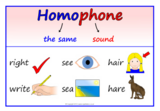
Assignment for Ed Tech Class.
- Subject:
- English Language Arts
- Material Type:
- Module
- Author:
- Jennifer Wall
- Date Added:
- 06/29/2022

Assignment for Ed Tech Class.
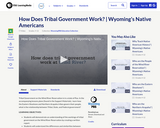
Tribal Government on the Wind River Reservation is in a state of flux. In the accompanying lessons plans (found in the Support Materials), learn how the Eastern Shoshone and Northern Arapaho tribes govern their people, what is the relationship between Tribal, State, and Federal government?
LEARNING OBJECTIVES:
Students will demonstrate an understanding of the workings of tribal government on the Wind River Reservation by creating a written report.
Students will understand the differences and similarities between state, tribal and federal governments and their functions, structures, and powers.

Students will be introduced to annotation and practice whole group, small group, and individually using a close read passage.
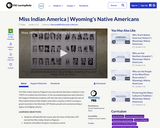
The Miss Indian America Pageant was launched by Sheridan residents in the 1950's to combat discrimination. In the accompanying lesson plan (found in the Support Materials) students will view the story told through the eyes of Miss Indian America title holders who held a reunion in 2013, serving as grand marshals in the Sheridan, WY Rodeo parade and commemorating a legacy of bridging cultures.
LEARNING OBJECTIVES:
Students will identify the reason why the town of Sheridan, WY started the Miss Indian America Pageant.
Students will define the given vocabulary words.

Story tells how Carl Erskine became lifelong friends with Johnny Wilson, then Jackie Robinson. Also, learn the story of how Carl compares his World Series ring and son Jimmy’s Special Olympics medal.32 pages Suggested for grades 4-6 ISBN: 979-8-9863985-1-8Library of Congress: GV861. L87 B76 2022

Purpose of UnitThe purpose of this Climate Science NTC Project GLAD® unit is a call to action, providing equity of access for all students. Through a model of instruction that promotes language development within core content, the Voices of Hope unit teaches students the science behind climate change and equips them with the tools necessary toward making a positive impact on our planet. This unit was written for 4th - 7th grade.
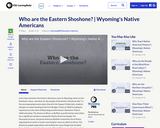
Learn how and when the Eastern Shoshone came to Wyoming, what are the Shoshone values, and what are the people of the Eastern Shoshone like? In the accompanying lessons plans (found in the Support Materials), students will gain an understanding of the Fort Bridger Treaty of 1868 including its importance to the state of Wyoming and the Eastern Shoshone Tribe in 1868 and today. The American Bison, or Buffalo as preferred by most tribes, has a significant existence among the Native American people. For thousands of years, the great American Buffalo roamed the Great Plains, migrating from north to south, searching for areas on which to thrive. The Shoshone people depended on the buffalo for many things that included food, clothing, and shelter. Every part of the buffalo was used and provided for the people.
LEARNING OBJECTIVES:
Students will study (Highlight, paraphrase and report) the Treaty of 1868 between the Eastern Shoshone Tribe and the United States Government.
Students will learn about the Eastern Shoshone people through the use of research and technology.
Students will understand that the history of the Shoshone people in the Wind River Mountains dates back thousands of years.
Students will understand that the circle of life continues in a perpetual cycle and is passed on through oral tradition. These stories often taught a lesson to young people.
Students will understand the indigenous perspective of interconnectedness. Students will understand how bison populations were devastated by western expansion.
Students will learn how to construct, read, compare and analyze different population graphs.
Students will understand how the diets of the Shoshone people varied depending on the areas in which they lived.
Students will acquire knowledge of the Wind River Reservation communities and be able to identify these locations on a map.
Students will be able to further describe how their culture has shaped them.
Students will be able to define the concept of culture.
Students will be able to explain some of the attributes of culture.
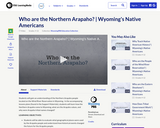
Students will gain an understanding of the Northern Arapaho people located on the Wind River Reservation in Wyoming. In the accompanying lessons plans (found in the Support Materials), students will learn how the Northern Arapaho come to Wyoming, what are the Arapaho values, and why were Arapaho tribal names changed?
LEARNING OBJECTIVES:
Students will be able to evaluate what geographical places were used by the Arapaho people and understand how historical events changed the future for the Arapaho people.
Students will compare and contrast between their social and ceremonial structures.
Students will understand the hierarchy of the Arapaho Tribe.
Students will analyze how their social and ceremonial structures contribute to their cultural identity.